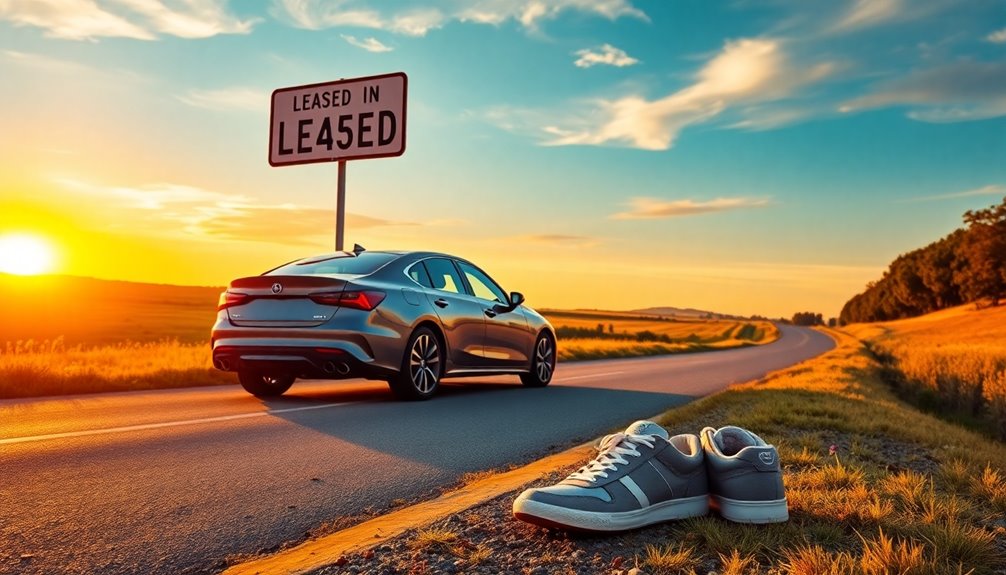When you lease a car, you usually have an annual mileage limit set between 10,000 and 15,000 miles. If you exceed this limit, expect to face excess charges of around $0.15 to $0.25 per mile. If you drive more, consider a high mileage lease option, which can allow for 15,000 to 20,000 miles per year, though it typically comes with higher monthly payments. To avoid penalties, it's smart to assess your driving habits and negotiate the mileage cap at lease signing. There's plenty more to understand about leases and fees, so keep exploring your options.
Key Takeaways
- Lease agreements typically set annual mileage limits between 10,000 to 15,000 miles.
- High mileage leases allow for 15,000 to 20,000 miles per year, with higher monthly payments.
- Exceeding the mileage limit incurs excess charges ranging from $0.15 to $0.25 per mile.
- It's essential to assess your driving habits to choose a suitable mileage cap.
- Regularly monitoring mileage helps avoid unexpected penalties and maintain the vehicle's condition.
Understanding Leasing Basics
When you lease a car, understanding the basics is essential to making the right choice for your driving needs. One key aspect is the lease agreement, which typically includes an annual mileage limit. This limit usually ranges from 10,000 to 15,000 miles, so it's vital to choose a mileage cap that aligns with your driving habits.
If you exceed this limit, you'll face excess mileage charges, often around $0.15 to $0.25 per additional mile.
If you anticipate driving more than the standard limit, consider high mileage leases, which offer increased flexibility for a higher monthly lease payment. Before signing your lease, assess your expected miles per year to avoid unexpected costs.
Standard Mileage Limits

Standard mileage limits in car leases play an important role in determining your overall leasing experience. Typically, standard leases allow for mileage limits ranging from 10,000 to 15,000 miles per year, depending on your agreement.
It's essential to set these limits at the beginning of the lease, as adjustments during the lease term are generally not permitted.
If you exceed the agreed-upon mileage limit, you'll likely face additional charges, which can range from $0.15 to $0.25 per mile. These costs can add up quickly, so understanding your driving habits before signing the lease is critical.
By evaluating how much you typically drive, you can select the right mileage limit that aligns with your lifestyle and avoid unexpected expenses at the end of the lease term.
For those who anticipate high mileage, there are options available for high mileage leases, offering increased flexibility but at an additional cost.
High Mileage Lease Options

For drivers who frequently rack up miles, high mileage lease options provide a practical solution. These leases typically allow for 15,000 to 20,000 miles per year, accommodating your extensive travel needs far better than standard lease terms, which usually cap at 12,000 miles.
If you're worried about excessive wear on the vehicle, high mileage leases can alleviate that concern by giving you the freedom to drive without constantly monitoring your mileage.
While the monthly payments for high mileage lease options are generally higher than those of standard leases, the increased allowance can save you from costly excess mileage charges, which can range from $0.18 to $0.25 per mile.
By opting for a high mileage lease, you'll avoid those additional mileage fees that can quickly add up.
It's essential to discuss your specific mileage needs with a lease broker before signing a lease contract. They can help tailor an agreement that suits your driving habits, ensuring you get the best deal while driving a new vehicle.
With the right high mileage lease option, you can enjoy the freedom to travel without the stress of exceeding your limits.
Penalties for Exceeding Mileage

Exceeding the mileage limit on a leased car can lead to costly penalties that greatly increase your overall expenses. Most leases set an annual mileage cap, typically between 10,000 and 15,000 miles a year.
If you go over this mileage limit, you'll face excess mileage charges that usually range from $0.15 to $0.25 per mile. For frequent drivers, these costs can add up quickly, leaving you with unexpected additional fees at the end of your lease term.
It's essential to understand that the mileage limits are established at the lease signing and can't be adjusted later. So, if you anticipate driving more, it's wise to negotiate a higher mileage limit upfront.
Additionally, be aware that penalties for excessive wear, like dents and scratches, can also apply at lease end, further increasing your costs.
To avoid these financial surprises, make it a habit to monitor your mileage throughout the lease term. Keeping an eye on your usage will help you stay within the set limits and maintain the vehicle's condition, ensuring you only face charges for normal wear and tear.
Adjusting Lease Terms

If you find yourself worried about exceeding the mileage limit on your leased car, adjusting lease terms can be a smart move. Before signing the lease agreement, make sure to negotiate a higher mileage limit if you expect to drive more than the standard 10,000 to 15,000 miles per year. This can help you avoid hefty penalties for extra miles.
Many leasing companies allow you to pre-purchase additional miles at a reduced rate, which is often more cost-effective than paying penalties later. However, keep in mind that adjusting lease terms, including mileage limits, might lead to higher monthly payments. Understanding the financial implications is essential.
Before finalizing your lease, confirm with the leasing company whether they offer flexibility in adjusting the mileage limit, as policies can vary considerably.
Here's a quick overview of options:
| Option | Description | Financial Impact |
|---|---|---|
| Negotiating Mileage | Increase limit before signing | Possible higher payments |
| Pre-purchasing Extra Miles | Buy miles in advance at discount | Lower cost than penalties |
| Fixed Mileage Limit | Standard agreement | Avoids negotiation stress |
Driving Habits Assessment

Evaluating your driving habits is vital when leasing a car, as it helps you choose the right mileage limit for your needs. Typically, annual mileage limits range from 10,000 to 15,000 miles per year. If you exceed this limit, you could face substantial excess mileage fees, usually between $0.15 to $0.25 per mile.
To avoid unexpected charges, it's important to accurately estimate your driving needs before signing a lease. Many lessees underestimate their annual mileage. To make a realistic assessment, review your past driving patterns and consider future plans like road trips or long commutes. This insight will help you gauge how many miles you'll actually drive.
If you anticipate that your driving habits will exceed the standard mileage limits, discuss high mileage lease options with your broker. These tailored solutions can save you from costly fees and guarantee that you lease a vehicle that fits your lifestyle.
Understanding your driving habits isn't just about staying within limits; it also helps you decide whether leasing or buying is more suitable based on your anticipated mileage and related costs.
Financial Considerations

When leasing a car, understanding your financial considerations is vital to making a smart decision. Most standard leases come with a mileage limit between 10,000 and 15,000 miles per year. If you exceed this limit, you'll face extra charges that can add up quickly, typically around $0.15 to $0.25 per mile driven. High mileage leases may be a better fit if your driving habits suggest you'll exceed these limits; however, they often come with higher monthly payments.
When choosing a lease, it's important to understand the residual value, as it impacts your monthly payments and potential penalties for excessive wear. Here's a quick breakdown of the potential costs:
| Factor | Consideration |
|---|---|
| Mileage Limit | 10,000 – 15,000 miles/year |
| Extra Charges | $0.15 – $0.25/mile |
| High Mileage Leases | Higher monthly payments |
| Residual Value Impact | Affects lease costs |
| Evaluating Driving Habits | Essential for smart leasing |
End of Lease Options

As your lease comes to an end, you'll need to contemplate your options carefully. You typically have three primary choices: return the vehicle, enter into a new lease, or purchase the leased vehicle.
If you decide to return the vehicle, be prepared for an inspection. This is where any excess wear and tear or mileage overage could result in additional charges, so keep an eye on those miles.
Choosing to enter into a new lease can make the change smoother since you can often handle it through the same dealership. This option can be appealing if you're looking for a different vehicle without the hassle of searching elsewhere.
On the other hand, if you're satisfied with your current car, purchasing it might be the best move for you. This usually comes with a predetermined buyout price, making it easier to decide.
Just be cautious of any disposition fees or extra charges you might face when you return the vehicle. Weigh your choices carefully to guarantee that you select the option that best fits your needs and financial situation as the end of your lease approaches.
Frequently Asked Questions
What Is the Maximum Mileage on a Lease?
The maximum mileage on a lease typically ranges between 10,000 to 15,000 miles per year, but it can vary based on your lease agreement.
If you drive more, high mileage leases might suit you better, allowing up to 20,000 miles or more annually.
How Many Miles for a 3 Year Lease?
So, you think you can drive as much as you want with a 3-year lease? Well, think again!
Typically, you'll find yourself limited to 36,000 to 45,000 miles over those three years, which breaks down to about 12,000 to 15,000 miles each year.
If you're planning on a road trip every weekend, you might want to negotiate for a higher mileage limit to avoid those pesky overage fees.
How Much Is a Lease on a Car?
A lease on a $45,000 car typically costs between $600 and $700 per month.
The exact payment depends on factors like the lease term, interest rates, and the car's residual value. You might also need to make an initial down payment of about 10%, which is around $4,500.
Keep in mind that higher mileage options can raise your monthly payments, so think about your driving habits before signing the lease.
What Happens if You Run Out of Miles on a Lease?
If you run out of miles on your lease, you'll face extra charges for any miles you exceed, typically ranging from $0.15 to $0.25 per mile.
It's essential to keep an eye on your mileage throughout the lease term to avoid these surprise fees.
You might also want to take into account purchasing additional miles upfront if you think you'll go over the limit, as it often saves you money in the long run.
Conclusion
In your leasing journey, it's crucial to keep an eye on your mileage limits. You wouldn't want to find yourself facing hefty penalties unexpectedly. Coincidentally, as you assess your driving habits, you might discover that adjusting your lease terms can save you money. Whether you opt for a high mileage lease or explore end-of-lease options, staying informed can make all the difference. So, keep those wheels turning, but know your limits to avoid surprises!









